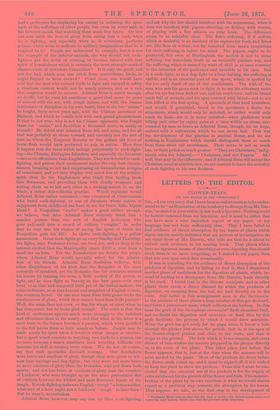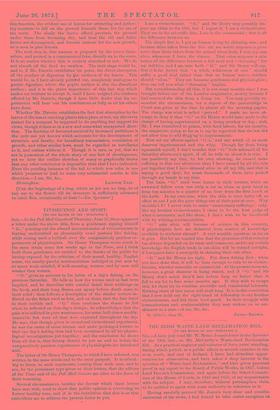LETTERS TO THE EDITOR.
FLOWER-TRAPS.
[TO TEE EDITOR OF THE " EPEOTATOR:]
Sin,—1 am very sorry that I have been so unfortunate as to be under- stood to be "an illustration of the tendency to diverge from Mr. Dar- win," as stated in yourarticle in last week's Spectator. Nothingcould be further removed from my intention, and it must be either that you have seen a very imperfect report of my paper, or my language has not been sufficiently clear. That I have failed to find evidence of direct absorption by the leaves of plants which digest insects merely indicates that my powers of investigation do not equal those of Mr. Darwin, who tells me that he is about to adduce such evidence in his coming book. That plants which have no apparent means of absorbing or even digesting flies should catch them is no more surprising, as I stated in my paper, than that our own eyes catch flies occasionally.
It was in searching for the evidence of direct absorption of the products of digestion, and by failing to find it, that I discovered another phase of usefulness for the digestion of plants, which, in- stead of leading to a divergence from Mr. Darwin, leads directly in his track. I found that in the Dionma muscipula and in other plants there exists a direct channel by which the products of digestion, on escaping from the leaf, are lead directly on to the roots. Still better is this arrangement seen in the Sarraccnix. In the pitchers of these plants a large number of flies get drowned, and form a putrescent mass, which collects at the bottom. In this mass the grub of the Sarcophaga sarracenie finds abundant food, and no doubt the digestion and excretion of dead flies by this grub facilitate the process to which I would draw attention. When the grub has got ready for its pupa state, it bores- a hole through the pitcher just above the petiole, that is, at the apex of the funnel-shaped pitcher and close to the roots, and then it drops to the ground. The hole which it bores remains, and every shower of rain washes the manure prepared in the pitcher directly on to the roots of the plant. This takes place just before the flower appears, that is, just at the time when the manure will be most needed by the plant. Most of the pitchers die down before the flower-stalk comes up, and it must be nipped off, if it is wished to keep the plant to show the pitchers. From this it must be con- cluded that one essential use of the pitchers is for the supply of extra nutriment for the growth of the flower and fruit. This manure- feeding of the plant by its own exertions is what we would almost expect as a previous step towards the absorption by the leaves. Thus suppose we take, as the first step in the development of
• Professor Riley tells us that this fly, and a moth—the Xanthroptera menferocea —are the only insects which can visit the pitchers with impunity.
this function, the evident use of leaves for attracting and gather- ing moisture to fall on the ground beneath them, for the use of the roots. The shade the leaves afford prevents the ground under them from becoming dry, and thus the old and fallen leaves are decomposed, and furnish manure for the new growth, as is seen in pine forests.
The next step is, that manure is prepared by the leaves them- selves, and poured in a concentrated form directly on to the roots. It is no matter whether this is entirely absorbed or not. We do not absorb all the food we swallow. The next stage would be, and is, if Mr. Darwin establishes his point, the direct absorption of the product of digestion by the surfaces of the leaves. This would be, as I have already pointed out, completely analogous to gastric digestion, where the peptic surface is also the absorbent surface ; and it is the grave importance of this last step which makes me hesitate to accept it, until I have weighed the evidence offered by Mr. Darwin, though I have little doubt that his ex- periments will bear out his conclusions as fully as all his others have done.
Whether Mr. Darwin establishes the fact that absorption by the leaves of the insect-catching plants takes place or not, my discovery cannot for a moment be supposed to do anything but support his views, though it does so in a new and somewhat unexpected direc- tion. The doctrine of favoured survival by increased usefulness is the only one yet known which accounts for the development of structure and faculty, for hereditary transmission, correlation of growth, and other similar laws, must be regarded as corollaries to it, and useless without it. Though it is rare, as yet, that we are in possession of the whole story of any fact of development, yet we have the outline sketches of many so graphically drawn that any other conclusion is impossible than that I have indicated. Even the puzzling instance of the tail to which you refer is one which promises to lead to some very substantial results in this direction.—I am, Sir, &c., [Can the beginnings of a trap, which as yet are no trap, be of any use to the flower, till its structure is sufficiently advanced to catch flies, occasionally at least ?—En. Spectator.]



































 Previous page
Previous page